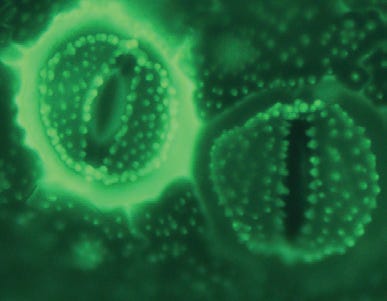Whenever I am asked to talk or write about the role of silicon-rich mineral waters in facilitating the excretion of aluminium from the body there follows the inevitable comment about how someone has been using some form of silicon supplement for years, ostensibly for the same reason. A common example of such is horsetail, often taken as a tea. Either individuals making these comments are not listening to me or reading my words carefully or I am not making myself clear.
Let me try a different approach. Horsetail (Equisetum arvense) grows liberally in my garden and has been a subject of my research for more than a decade. Horsetail accumulates silica in its tissues. Note the term silica, in this case referring to an amorphous form of silica (SiO2) of biological origin. Taking horsetail from my garden we decided to try to isolate the silica from the plant tissues. To achieve this we digested fresh horsetail using a combination of concentrated nitric and sulphuric acids (two of the strongest mineral acids) aided by a powerful microwave oven. The microwave assisted digestion is complete in about an hour and what remains is, well on first inspection, nothing. A clear solution. However, upon filtration using copious quantities of pure water to counter the acidity we isolated a pure white powder. What is this powder, we wondered. Infra red spectroscopy showed that it was pure silica. No trace of organic material, plant tissue, remained.
We decided to take a look at this white powder using fluorescence microscopy. What we found was almost incredible. Rarely have I been more surprised, amazed and excited by our science. Do take a look at the published paper to understand exactly what I mean. However, what do you biologists out there think is shown by this image?
How about stomata, the structures found on leaves and elsewhere that allow for the movement of oxygen and carbon dioxide in and out of the plant. Well yes and no. Remember, this is an image of the white powder isolated using microwave digestion from horsetail tissue. The image shows silica and how it is deposited in the plant tissue, in this case reproducing the detailed structure of plant stomata. Think of it as something akin to a fossil-like reproduction of horsetail tissue. Truly incredible and a landmark moment in our research.
However, the moral of this story of beautiful science is that when you attempt to digest horsetail tissue with two of the strongest mineral acids on the planet the silica remains. So, when you prepare your tea made of horsetail you imbibe a solution that may contain some organic material and perhaps some silica. However, your tea is not what we define as silicon-rich in that it contains very little silicic acid, the magic required to facilitate the removal of aluminium from the body. Do check our website to read many other papers on this subject with fascinating images of biological silica including in other plants such as hemp.





Chris, I appreciate all the science, study and findings you mention in every article and discussion you present for us to learn and share. And share I do. “Thank you” could never express my gratitude for ALL you continue to give ! My hope is that my friends and family would make time to listen to your research - so their health AND their childrens’ future could be better preserved!!!!
Fascinating image!